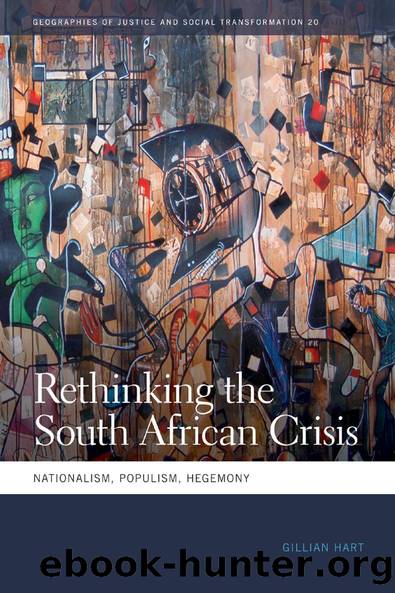Rethinking the South African Crisis by Gillian Hart

Author:Gillian Hart [Hart, Gillian]
Language: eng
Format: epub
Tags: History, Africa, South, Republic of South Africa, Political Science, Human Rights, Social Science, Human Geography
ISBN: 9780820347172
Google: YJ4KAwAAQBAJ
Publisher: University of Georgia Press
Published: 2014-01-15T05:42:37+00:00
The Political Maelstrom of Indigence
A maelstrom (or malström/malstrøm in the Scandinavian languages) is a very powerful whirlpool; a large, swirling body of water. A free vortex, it has considerable downdraft (http://en.wikipedia.org; emphasis in original).
When I returned to Ladysmith in mid-2005, the big story was how efforts to register households as indigent were spreading very rapidly. Early in 2005, at the start of the surge, some 5 000 households in Ladysmith/Emnambithi were registered as indigent â approximately 12 per cent of the roughly 40 000 urban and township households in the municipality. By 2007, the number of âindigentâ households had climbed to around 20 000. This was, of course, a period in which the equitable share was also increasing significantly (Table 3.1).
Mindful of the earlier experiment with indigence in Ladysmith, reports from other parts of the country and theoretical preconceptions, my immediate reaction was that being defined as indigent must be a belittling and demeaning source of shame. When I tried to probe this issue with ANC councillors, they immediately responded in terms such as âactually itâs a wonderful thingâ and âoh no, people love it!â The newly defined âindigentsâ with whom I spoke confirmed this view, conveying a sense that the government was at last providing some of the support to which they were entitled. What also became clear was that the connotations of âindigenceâ in English â a sort of Dickensian image of the cringing poor in nineteenth-century London â has no cognate in isiZulu, and that indigence was being defined and understood in terms such as âgiving to people who donât have enoughâ and ârestoring our dignityâ.
The initial impetus came from municipal officials. Until 2004/05 they had relied on an intricate, administratively costly and time-consuming questionnaire to assess indigence that was focused mainly on households in Acaciaville and Steadville. In 2005, partly in an effort to incorporate Ezakheni households in a comprehensive indigent register in the most efficient way possible, they instituted a system of automatic indigence that the chief financial officer described as follows: âWhere a house value is equal to or less than the national housing subsidy â R36 720 â we give them everything for free. We will rebate 100 per cent of houses in that category. It takes out poor people â you canât expect them to pay.â
He went on to say that this is much more efficient than chasing them up with bills that they can never pay, and estimated some 7 000â8 000 households fell in this category. Those who qualified had their arrears written off, paid no rates and received free refuse removal. The only downside was having to accept a prepaid electricity meter.33
The crucial point is that there were no restrictions on water in Ezakheni. In December 2004, following its withdrawal from Uthukela Water Company, Uthukela district municipality took responsibility for water service provision. While residents of Ladysmith town complained that the provision of water and sanitation was every bit as bad â if not worse â than when the company was in charge, it was clear that things were (and still are) infinitely worse in Ezakheni.
Download
This site does not store any files on its server. We only index and link to content provided by other sites. Please contact the content providers to delete copyright contents if any and email us, we'll remove relevant links or contents immediately.
| Central Africa | East Africa |
| North Africa | Southern Africa |
| West Africa | Algeria |
| Egypt | Ethiopia |
| Kenya | Nigeria |
| South Africa | Sudan |
| Zimbabwe |
Goodbye Paradise(2972)
Men at Arms by Terry Pratchett(2408)
Tobruk by Peter Fitzsimons(2064)
Pirate Alley by Terry McKnight(1911)
Arabs by Eugene Rogan(1838)
Borders by unknow(1789)
Belonging by Unknown(1472)
The Biafra Story by Frederick Forsyth(1327)
It's Our Turn to Eat by Michela Wrong(1305)
Botswana--Culture Smart! by Michael Main(1238)
A Winter in Arabia by Freya Stark(1226)
Gandhi by Ramachandra Guha(1196)
Coffee: From Bean to Barista by Robert W. Thurston(1184)
Livingstone by Tim Jeal(1153)
The Falls by Unknown(1142)
The Source by James A. Michener(1135)
The Shield and The Sword by Ernle Bradford(1102)
Egyptian Mythology A Fascinating Guide to Understanding the Gods, Goddesses, Monsters, and Mortals (Greek Mythology - Norse Mythology - Egyptian Mythology) by Matt Clayton(1088)
Africa: Altered States, Ordinary Miracles by Richard Dowden(1080)
